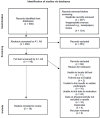Motivation to participate in structured physical activity for autistic youth: A systematic scoping review
- PMID: 38576064
- PMCID: PMC11459862
- DOI: 10.1177/13623613241240603
Motivation to participate in structured physical activity for autistic youth: A systematic scoping review
Abstract
Autistic youth participate less in physical education classes and organised sport than their neurotypical peers. We conducted a review of existing studies to investigate what is known about what motivates (and does not motivate) autistic youth to take part in structured physical activities. We systematically searched electronic databases and found 18 publications that met the criteria to be included in this review. Data from these studies were extracted and mapped to the self-determination theory to identify factors that support (or undermine) motivation for autistic youth. We also discussed the findings with autistic individuals and other relevant stakeholders to discover how the review related to their experiences. Our results found competence (youth feeling competent in their athletic and social skills and abilities) to be the most reported psychological need impacting motivation for autistic youth. Intrinsic motivation (participating for enjoyment and satisfaction) was the most common facilitator of motivation. Autism-specific themes outside of the self-determination theory were mapped inductively, and we found that the sensory environment was a prominent theme reported to influence the motivation of autistic youth not covered by the self-determination theory. The findings of this review suggest that supporting the psychological needs of autistic youth can foster motivation to engage in physical activity, although how these needs are met can differ from their neurotypical peers. Future research should examine motivational factors that support engagement in structured physical activities through the lens of autistic youth and their experiences.
Keywords: adolescents; autism; autism spectrum disorders; environmental factors; motivation; physical activity; school-age children; self-determination theory; youth.
Conflict of interest statement
Declaration of conflicting interestsThe author(s) declared no potential conflicts of interest with respect to the research, authorship, and/or publication of this article.
Figures
Similar articles
-
Social motivation by self- and caregiver-report: Reporter concordance and social correlates among autistic and neurotypical youth.Autism Res. 2024 Jan;17(1):55-65. doi: 10.1002/aur.3054. Epub 2023 Nov 21. Autism Res. 2024. PMID: 37987233 Free PMC article.
-
Autism voices: Perspectives of the needs, challenges, and hopes for the future of autistic youth.Autism. 2023 May;27(4):1142-1156. doi: 10.1177/13623613221132108. Epub 2022 Nov 3. Autism. 2023. PMID: 36329663
-
A Self-Determination Theory Approach to Work Motivation of Autistic Adults: A Qualitative Exploratory Study.J Autism Dev Disord. 2023 Apr;53(4):1529-1542. doi: 10.1007/s10803-021-05185-4. Epub 2021 Jul 14. J Autism Dev Disord. 2023. PMID: 34263411 Free PMC article.
-
Does Self-Determination Theory Associate With Physical Activity? A Systematic Review of Systematic Review.Int J Psychol. 2025 Jun;60(3):e70044. doi: 10.1002/ijop.70044. Int J Psychol. 2025. PMID: 40256835 Review.
-
Can We Motivate Students to Practice Physical Activities and Sports Through Models-Based Practice? A Systematic Review and Meta-Analysis of Psychosocial Factors Related to Physical Education.Front Psychol. 2019 Oct 10;10:2115. doi: 10.3389/fpsyg.2019.02115. eCollection 2019. Front Psychol. 2019. PMID: 31649571 Free PMC article.
Cited by
-
Development and Further Content Validation of the Motivation Assessment Tool for Physical Activity (MATPA) Among Children with Autism Spectrum Disorder.J Autism Dev Disord. 2025 Apr 23. doi: 10.1007/s10803-025-06824-w. Online ahead of print. J Autism Dev Disord. 2025. PMID: 40266441
-
Enhancing home-based physical activity for neurodivergent children: adapting the InPACT at Home program with AI and universal design.Front Physiol. 2025 Jan 7;15:1496114. doi: 10.3389/fphys.2024.1496114. eCollection 2024. Front Physiol. 2025. PMID: 39839530 Free PMC article.
-
The efficacy, mechanisms and implementation of physical activity as an adjunctive treatment in mental disorders: a meta-review of outcomes, neurobiology and key determinants.World Psychiatry. 2025 Jun;24(2):227-239. doi: 10.1002/wps.21314. World Psychiatry. 2025. PMID: 40371806 Free PMC article.
-
Exercise Interventions for Autistic People: An Integrative Review of Evidence from Clinical Trials.Curr Psychiatry Rep. 2025 May;27(5):286-306. doi: 10.1007/s11920-025-01597-6. Epub 2025 Mar 12. Curr Psychiatry Rep. 2025. PMID: 40075048 Free PMC article. Review.
References
-
- Alsoqairan T. (2019). Comparison of physical intensity between interactive video game cycling and conventional stationary cycling in adolescents with high functioning autism spectrum disorder [PhD dissertation, University of Arkansas]. Graduate Theses and Dissertations. https://scholarworks.uark.edu/etd/3205
-
- American Psychiatric Association. (2013). Diagnostic and statistical manual of mental disorders (5th ed.).
-
- Anderson D. C. (2011). Motivating children with autism to ride a stationary recumbent bicycle using contingent and delayed reinforcement [Educational Psychology 3500]. Dissertation Abstracts International Section A: Humanities and Social Sciences, 72(10-A), 3689. https://www.proquest.com/dissertations-theses/motivating-children-with-a...
-
- Arnell S., Jerlinder K., Lundqvist L.-O. (2018). Perceptions of physical activity participation among adolescents with autism spectrum disorders: A conceptual model of conditional participation. Journal of Autism and Developmental Disorders, 48(5), 1792–1802. 10.1007/s10803-017-3436-2 - DOI - PMC - PubMed
Publication types
MeSH terms
LinkOut - more resources
Full Text Sources
Medical
Miscellaneous



